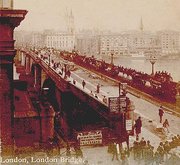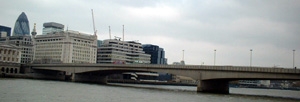London Bridge
|
|
- This article is a text about the bridge in London. For other meanings, see London Bridge (disambiguation); for the nearby overground and underground railway station, see London Bridge station.
London Bridge is a bridge over the River Thames, between the City of London and Southwark. It is between Cannon Street Railway Bridge and Tower Bridge; it also forms the western end of the Pool of London. London's original bridge made this one of the most famous bridge emplacements in the world. It was the only bridge over the Thames in London until Westminster Bridge was opened in 1750.
On the south side of the bridge is Southwark Cathedral and London Bridge station. On the north side is the Monument to the Great Fire of London and Monument tube station.
The bridge is designated as part of the A3 road, maintained by the Greater London Authority.[1] (http://www.hmso.gov.uk/si/si2000/20001117.htm)
| Contents |
History
A bridge has existed at or near the present site for nearly 2,000 years. The first bridge across the Thames in the London area was built by the Romans on the present site around AD 46 and was made of wood. The location was most likely chosen as a bridgeable spot which still had deepwater access to the sea. The bridge fell into disrepair after the Romans left, but at some point either it was repaired or a new timber replacement constructed, probably more than once. In 1014, the bridge was burned down by King Ethelred in a bid to divide the invading forces of the Dane Svein Haraldsson. This episode reputedly inspired the well-known nursery rhyme London Bridge is falling down. The rebuilt London Bridge was destroyed by a storm in 1091 and yet again, this time by fire, in 1136.
Old London Bridge

Following the 1136 destruction of London bridge, its maintainer Peter de Colechurch proposed to replace the timber bridge with a permanent stone construction. William Rufus levied a tax to fund the new stone bridge, and construction of a new stone bridge was begun in the reign of Henry II, under de Colechurch's direction, in 1176. The new bridge took 33 years to complete and was not finished until 1209, four years after de Colechurch died, in the reign of King John.
John had the idea to build houses on the bridge, and it was soon colonised by houses, shops and even a chapel built at the centre of the bridge (dedicated to the recently martyred and canonised Thomas a Becket, who, appropriately had been born in the parish of St Mary Colechurch). Contemporary pictures show it crowded with buildings of up to seven stories in height. The population of the bridge was such that it was made a ward of the City with its own alderman, which it retained until the 18th century.
The medieval bridge had 19 small arches and a drawbridge with a gatehouse at each end. The narrowness of the arches meant that it acted as a partial barrage over the Thames, blocking an estimated 80% of the river flow. The current was further obstructed by the addition of water-wheels under the two north arches to drive water pumps, and under the two south arches to power grain mills. This produced ferocious rapids between the piers or "starlings" of the bridge, as the difference between the water levels on each side could be as much as six feet (two metres). Only the brave or foolhardy attempted to "shoot the bridge" – steer a boat between the starlings – and many were drowned trying to do so. As the saying went, the bridge was "for wise men to pass over, and for fools to pass under".
Various arches of the bridge collapsed at various points, and houses on the bridge were burnt during Wat Tyler's Peasants' Revolt in 1381 and Jack Cade's rebellion in 1450.
The northern gate, the New Stone Gate, was replaced by Nonesuch House in 1577. The southern gatehouse, the Stone Gateway, became the scene of one of London's most notorious sights: a display of the severed heads of traitors, impaled on pikes and dipped in tar to preserve them against the elements. The head of William Wallace was the first to appear on the gate, in 1305, starting a tradition that was to continue for another 355 years. Other famous heads on pikes included those of Jack Cade in 1450; Sir Thomas More in 1535; Bishop John Fisher, also in 1535; and Thomas Cromwell in 1540. A German visitor to London in 1598 counted over thirty heads on the bridge. The practice was finally stopped in 1660, following the Restoration of King Charles II.
The buildings on London Bridge created a major fire hazard and served to increase the load on its arches, so it is not surprising that there were several disasters on the bridge. In 1212 or 1213, a major fire broke out on both ends of the bridge simultaneously, trapping many in the middle and reportedly resulting in 3,000 people being killed. Another major fire broke out in 1633 with the northern third of the bridge being destroyed, although this prevented the bridge from being damaged by the Great Fire of London in 1666. By 1722, congestion was becoming so serious that the Lord Mayor decreed that "All carts, coaches and other carriages coming out of Southwark into this City do keep all along the west side of the said bridge: and all carts and coaches going out of the City do keep along the east side of the said bridge". This is possibly the origin of traffic in Britain driving on the left. Finally, in 1758–1762, the houses were removed along with the two centre arches, replaced with a single wider span to improve navigation on the river.
New London Bridge

By the start of the 19th century, it was apparent that the old London Bridge – by now over 600 years old — needed to be replaced. It was narrow, decrepit and a hazard to river traffic. In 1799, a competition for designs to replace the old bridge was held, prompting the engineer Thomas Telford to propose a bridge with a single iron arch spanning 600 ft (180 m). The revolutionary nature of this design won praise but it was never used, due to uncertainty about its feasibility and the amount of land needed for its construction.
The bridge was eventually replaced by an elegant structure of five stone arches, designed by engineer John Rennie. The new bridge was built 100 feet (30 m) west (upstream) of the original site at a cost of £2,000,000 and was completed by Rennie's son (of the same name, confusingly) over a seven-year period from 1824 to 1831. The old bridge continued in use as the new bridge was being built, and was demolished after the new bridge opened in 1831.
Rennie's bridge was constructed from Dartmoor granite, with a length of 928 feet (283 m)and a width of 49 feet (15 m). The official opening took place on August 1, 1831; King William IV and Queen Adelaide attended a banquet in a pavilion erected on the bridge. It was widened in 1902–1904 from 52 to 65 feet (16 to 20 m) in an attempt to combat London's chronic traffic congestion. Unfortunately, this proved too much for the bridge's foundations; it was subsequently discovered that the bridge was sinking an inch every eight years. By 1924, the east side of the bridge was some three to four inches lower than the west side.
London_Bridge_Lake_Havasu.jpg
In 1968, Rennie's bridge was sold to the American entrepreneur Robert P. McCulloch for the sum of $2,460,000 (it has been claimed that he was under the mistaken belief that he was buying Tower Bridge, though McCulloch himself strongly denied this). The bridge was shipped piece by piece to Lake Havasu City, Arizona, where it was reconstructed and dedicated on October 10, 1971. (Not all of the bridge was transported to America; some was kept behind in lieu of tax duties and was eventually auctioned in 2003.) Rennie's London Bridge spans a canal that leads from Lake Havasu to Thompson Bay. It forms the centrepiece of what amounts to an ersatz English theme park complete with mock-Tudor shopping mall. Somewhat surprisingly, Rennie's London Bridge has become Arizona's second biggest tourist attraction after the Grand Canyon.
Modern London Bridge
The current London Bridge was constructed by contractors John Mowlem from 1967 to 1972, and opened by Elizabeth II in 1973. It is a fairly dull edifice comprising three spans of pre-stressed concrete cantilevers, paid for in part by the sale of the earlier Rennie bridge. It is 928 feet (283 metres) long. The cost of £4m was met entirely by the City of London's Bridge House Estates. The current bridge was built in the same location as Rennie's bridge, which was carefully demolished piece by piece as the new bridge was built, so the bridge would remain in use throughout.
On Remembrance Day 2004, various London bridges were furnished with red lighting as part of a night-time flight along the river by wartime aircraft. The red lighting on London Bridge considerably improved its drab appearance, so it has been left on the bridge (but not the other bridges) and lights it at night.
External links
Template:Pic Template:Mmuk maphot
- Southwark Council page with more info about the bridge (http://www.southwark.gov.uk/CultureHeritage/HistoricSouthwark/LondonBridge.html)
- Lyrics to the song 'London Bridge is falling down' (http://www.zelo.com/family/nursery/london.asp)
- Virtual reality tour of Old London Bridge (http://www.bbc.co.uk/history/society_culture/architecture/launch_vr_london_bridge.shtml)
| Bridges of Central London, west to east |
|---|
| Chelsea Bridge | Grosvenor Bridge | Vauxhall Bridge | Lambeth Bridge | Westminster Bridge |
| Hungerford Bridge | Waterloo Bridge | Blackfriars Bridge | Blackfriars Railway Bridge |
| Millennium Bridge | Southwark Bridge | Cannon Street Railway Bridge | London Bridge | Tower Bridge |
| See also: Crossings of the River Thames | Bridges of the United Kingdom |

